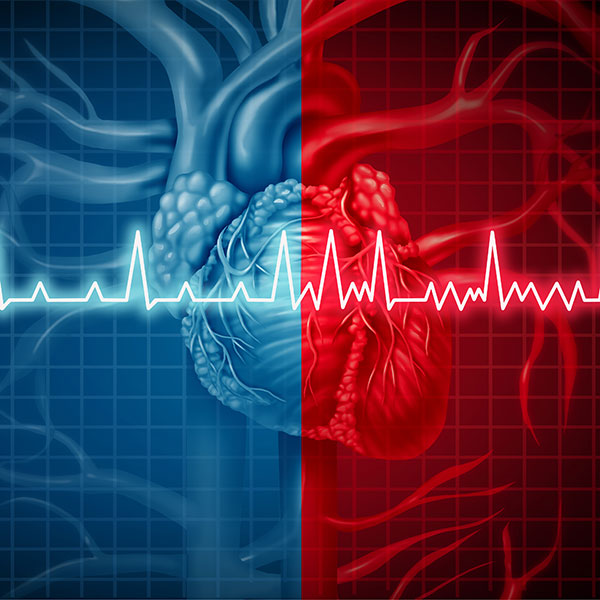Cover Story | Impact and Consequences of Atrial Fibrillation

Atrial fibrillation (AFib) is the most common sustained arrhythmia, with a rising prevalence leading to increased comorbidities, including stroke, heart failure (HF) and dementia. AFib affects an estimated 2.7 to 6.7 million people in the U.S., with 5.6 to 15.9 million cases expected by 2050.1 Globally, AFib was estimated at 33.5 million people in 2010, with approximately 5 million new cases diagnosed annually.1
The risk for AFib increases with advancing age — more than one-third of patients with AFib are 80 years or older.2 AFib is more common among men than women, with an estimated 20.9 million men compared to 12.6 million women having AFib worldwide.3 The incidence and prevalence of AFib are higher in people of European ancestry than in other ethnic groups3 and AFib appears to be less common among African Americans.2
AFib Burden Increases Stroke Risk

AFib burden has been variously defined as the percentage of monitored time in AFib,7 the longest total atrial tachycardia or AFib duration on any given day during the prior 30-day period2 or as the presence of atrial tachyarrhythmia for longer than six minutes.5 “We now have evidence that the greater the burden of AFib, the higher the risk of stroke,” says Lin Y. Chen, MD, MS, FACC. “In the past we have only thought of whether the person has AFib or no AFib. The CHA2DS2-VASc score does not even consider the amount of AFib a person has.” Chen defines AFib burden as the percentage of time a patient is in AFib, as determined by monitoring with a continuous ECG recording device.7,12
Because continuous ambulatory monitoring has not been practical for all patients with AFib, most studies looking at AFib burden have focused on AFib type or pattern or device-detected AFib duration as measured by a cardiac implantable electronic device. However, the development of a wearable continuous monitoring patch has made it more practical to quantitate time in AFib. “There are now heart rhythm patch monitors that look like a bandage that can be stuck on the chest with no wires or electrodes. So patients and research participants are more inclined to wear this than very clunky monitoring devices,” says Chen. “The other important consideration is that this patch can monitor for a longer period of time — one or two weeks, as opposed to Holter monitors that can only monitor for up to 48 hours,” he says. READ MORE
AFib is a supraventricular tachyarrhythmia with uncoordinated atrial activation and ineffective atrial contraction. Electrocardiography (ECG) during AFib reveals irregular R-R intervals, absence of P waves and irregular atrial activity. Nonvalvular AFib refers to AFib in the absence of rheumatic mitral stenosis, prosthetic heart valve or mitral valve repair.2
AFib is categorized according to duration of episode:2,4
- Paroxysmal AFib resolves spontaneously or with intervention within seven days of onset.
- Persistent AFib is sustained for more than seven days even with treatment or direct current cardioversion.
- Long-standing persistent AFib lasts for ≥12 months duration.
- Permanent AFib does not resolve with treatment.
Pathophysiology
Atrial structural or electrophysiological abnormalities can lead to abnormal impulse formation and propagation, resulting in the rapid, uncoordinated atrial activity characteristic of AFib.2 Rapid triggering is thought to initiate propagating reentrant waves in a vulnerable atrial substrate.5 The focal rapid firing most commonly arises in the left atrial myocardial sleeves extending into the pulmonary veins.2 Rapid ectopic activity can also originate in the muscular sleeves of the superior vena cava, coronary sinus or ligament of Marshall.4 The mechanisms behind the rapid firing are not fully understood but may involve automaticity, micro-reentry or triggered activity.4
Taking the Lead to Create an AFib Clinic

The value of a dedicated clinic for atrial fibrillation (AFib) is well known to Henry Huang MD, FACC, a member of ACC’s Leadership Academy Cohort II. After experiencing the tangible benefits for staff and patients at one hospital, he led the creation of an AFib clinic at Rush University Medical Center (RUMC), where he’s now a faculty member and specializing in clinical cardiac electrophysiology.
Establishing the RUMC AFib Clinic was Huang’s capstone project, the final project of the Leadership Academy. The capstone project is meant to test and develop the skills of the participants as early career leaders, enhance leadership involvement within the ACC, and potentially further strategic priorities of the College. READ MORE
Atrial stretch, inflammation and genetic factors lead to molecular and histologic changes in the atrial substrate that promote fibrosis and reduced cell coupling, impairing normal conduction.2,5
- Systemic inflammation and inflammation from epicardial adipose tissue may induce atrial remodeling that promotes fibrosis.5
- Atrial stretch activates the renin-angiotensin-aldosterone system, resulting in production of profibrotic factors.2
- Fibroblasts electrically couple to cardiomyocytes, proliferate and promote ectopic activity or reentry.4
- Increasing fibrosis further promotes AFib, potentially inducing progression of paroxysmal AFib to persistent AFib.4
- Extended periods of continuous AFib impair the ability to restore and maintain normal sinus rhythm.5
Atrial structural abnormalities such as inflammation, fibrosis and hypertrophy are usually the result of underlying heart disease associated with hypertension, coronary artery disease, valvular disease, cardiomyopathies or HF.2 These disorders increase left atrial pressure, cause atrial dilation and alter wall stress. Other cardiac conditions that can promote AFib include amyloidosis, hemochromatosis and sarcoidosis. Extracardiac conditions associated with AFib include diabetes, hyperthyroidism and obstructive sleep apnea.4,5 Nonmodifiable risk factors include genetics, age, sex and race. Modifiable risk factors include reduced physical activity, smoking, increased body mass index, obstructive sleep apnea, increased blood pressure and alcohol consumption.5
Obesity, which contributes to an inflammatory state, can cause paroxysmal AFib to advance to persistent AFib.4 (For more on the inflammatory state in obesity, see the cover article in the July issue of Cardiology).
People with AFib may initially be asymptomatic, referred to as silent or subclinical AFib. The most common symptom is fatigue. Patients may also experience palpitations, dyspnea, hypotension, syncope or heart failure.2
Consequences of AFib
AFib is a major cause of stroke, accounting for up to 125,000 strokes annually in the U.S.6 Approximately 40 percent of all strokes in patients >80 years of age are associated with AFib. With the rising prevalence of AFib, the percentage of patients admitted for acute ischemic stroke with AFib increased from 16 percent in 2003 to 20 percent in 2014.6 Further, patients with AFib have increased rates of in-hospital death, 30-day mortality and one-year mortality from stroke than patients without AFib.5
The increased risk of stroke is thought to be caused by reduced left atrial appendage (LAA) emptying resulting in blood stasis.5 Other contributing factors are atrial abnormalities and a prothrombotic state in patients with AFib.5 Estimates of stroke risk are based on patient risk factors using risk stratification schemes such as the CHA2DS2-VASc score.2 AFib burden also has emerged as an important factor affecting stroke risk.7,8
The risk of extracranial thromboembolism is increased in patients with AFib, with the highest risk occurring during the first year of AFib.5 AFib also confers an adjusted 2.5-fold higher risk of cognitive impairment and dementia.5
HF is both a risk factor and a complication of AFib. AFib is more highly associated with HF with preserved ejection fraction than HF with reduced ejection fraction. HF in patients with AFib is caused by similar mechanisms responsible for AFib, including myocardial inflammation and fibrosis.5 Myocardial infarction is also a risk factor and a consequence of AFib.5 AFib is associated with increased mortality in both men and women.5
Other cardiovascular outcomes that can result from AFib include myocardial infarction, systemic embolic events and dementia.5
Detection of AFib
Case Report Tachycardiomyopathy Detection: Moving Beyond Arrhythmia Detection With Kardia Band

In the fast expanding world of mobile Health (mHealth), the Kardia Band (KB) device functions like an electrocardiogram (ECG) and when paired with an Apple Watch (AW) can detect and display an ECG plethysmography. Here we report a unique patient-centered use of the AW/KB to detect atrial fibrillation (AFib) and tachycardiomyopathy.
A 57-year-old woman with a history of obstructive sleep apnea, hypertension, paroxysmal AFib on chronic anticoagulation and a previously normal ejection fraction (EF) presented for an elevated heart rate (HR) detected by an AW/KB. The single-lead KB was being used to regularly track her HR (Figure 1). The patient reported feeling fatigued but was alarmed by HRs in the range of 130-150 beats/min for a week. Physical examination revealed a HR of 133 beats/min, BP 138/60 mm Hg with mild elevation in the jugular venous pulsation and irregularly irregular rhythm on cardiac auscultation. READ MORE.
The diagnosis of AFib is based on clinical history and physical examination and is confirmed by 12-lead ECG, ambulatory rhythm monitoring or implanted devices.2 ECG features of AFib are completely irregular R-R intervals, absence of P waves and coarse or fine fibrillation waves in the baseline.3
Screening of high-risk persons for detection of silent AFib is recommended in most guidelines but screening with 12-lead ECG is not cost effective.3 Instead, opportunistic screening via pulse palpation or ECG rhythm strip during routine medical visits is used.9 Studies of 30-second ECG screening have found incident AFib in 1 to 1.5 percent of older adults tested. Recent trials of implantable cardiac monitors (ICMs) have identified new AFib in 22 to 40 percent of participants with monitoring up to 30 months.9
Recent validation of new digital technologies for detecting AFib has enabled noninvasive, cost-effective AFib screening in vulnerable populations. One study evaluating a handheld smartwatch accessory that records a rhythm strip equivalent to lead I for 30 seconds and uses an automated algorithm for AFib diagnosis, supported by physician review, accurately detected AFib.10
In the mSToPS study of 2,659 high-risk individuals, immediate monitoring with a home-based wearable ECG sensor patch, compared with delayed monitoring, resulted in a higher rate of AFib diagnosis (3.9 vs. 0.9 percent) after four months.9 Monitored participants, compared with nonmonitored controls had higher rates of AFib diagnosis and greater initiation of anticoagulants for stroke prevention, although health care resource utilization was increased at one year.
According to an editorial comment, “The mSToPs data suggest that immediate, continuous screening for two weeks may be equivalent to weekly or biweekly, 30-second rhythm monitoring over a 12-month period in a population of similar risk.”11 Further studies are needed to determine whether earlier or more sensitive AFib detection improves clinical outcomes and whether it is cost-effective. According to the authors, there is good evidence that earlier AFib detection could affect clinical outcomes with regard to aggressive management of modifiable risk factors, rate control, symptom control and stroke prevention.11
Rate and Rhythm Control
Long-term ventricular rate control is used to reduce symptoms, improve quality of life, minimize development of HF and prevent thromboembolic complications.3 Rate control drugs include beta blockers, nondihydropyridine calcium antagonists, digoxin and amiodarone, alone or in combination. The choice of drug depends on patient age, lifestyle, associated comorbidities and heart rate. If pharmacotherapy is not effective, atrioventricular node ablation with pacemaker implantation or rhythm control may be used.3
Antiarrhythmic drugs (AADs) are the most common treatment for restoring and maintaining sinus rhythm. AADs are categorized into four classes based on mechanism of action:3
- Class I: Sodium channel blockers, including flecainide and propafenone
- Class II: Beta blockers
- Class III: Multichannel blockers, such as amiodarone
- Class IV: Calcium channel blockers
Electrical cardioversion may be required to restore sinus rhythm in patients with persistent AFib exceeding seven days. In some cases, AADs may be used together with electrical cardioversion to increase effectiveness.3
In patients with paroxysmal, persistent or long-standing persistent AFib for whom AADs are not effective or not tolerated, catheter ablation may be used. Ablation may also be used as first-line therapy in patients with symptomatic paroxysmal AFib. Surgical ablation usually is performed in patients undergoing cardiac surgery. LAA isolation can reduce postablation recurrence in patients with nonparoxysmal AFib.3
Anticoagulation and Stroke Prevention

Anticoagulation is necessary to prevent stroke and thromboembolism in most patients with AFib. “Atrial fibrillation remains undertreated with anticoagulation. I am referring to patients without contraindications who still are not receiving anticoagulation at the rate the data and guidelines suggest,” says Deepak L. Bhatt, MD, MPH, FACC.
The need for therapy and the type of anticoagulation are typically determined using the CHA2DS2-VASc stroke risk score.4
- CHA2DS2-VASc score of 0: no anticoagulant therapy
- CHA2DS2-VASc score of 1: anticoagulant therapy may not be necessary but oral anticoagulant or aspirin may be considered
- CHA2DS2-VASc score ≥2: anticoagulant therapy with warfarin or a direct-acting oral anticoagulant (DOAC)

According to Geoffrey D. Barnes, MD, MSC, FACC, the CHA2DS2-VASc and HAS-BLED scores are useful for estimating a patient’s risk of stroke or bleeding, respectively. “However, I do not think they are particularly useful in helping to identify which anticoagulant a patient should use. Rather, patients at sufficiently high risk of stroke should be started on anticoagulation,” he says. “For most patients in 2018, this means starting with a DOAC because of their efficacy, safety and ease of use.” Barnes notes that warfarin remains a good option for patients who may have difficulty affording the high cost of DOACs.
Implantable Cardiac Monitors
ICMs are increasingly being used to monitor AFib due to technological improvements, easier implant procedures and the capability for remote monitoring. Prolonged monitoring with ICMs has proven effective for detecting AFib in patients with cryptogenic stroke and for quantifying AFib burden.14,15 The sensitivity and specificity for detecting AFib with ICMs ranges from 96 to 100 percent and 67 to 86 percent, respectively.15 The recent introduction of ICMs with automatic AFib detection algorithms and continuous remote monitoring has enabled targeted anticoagulation guided by remote monitoring.14
Benefits and Limitations of ICM Monitoring in AFib15
Benefits
- Avoids subjective evaluation of therapy effectiveness
- Overcomes limits of intermittent monitoring
- Shortens time to obtain relevant information
Limitations
- Lack of clinical evidence of benefits to guide medical and device therapy
- Presence of false positive arrhythmic episodes
- Invasive procedure with risk of local complications
Studies have shown the benefits of stroke prevention across a wide range of patients, including those at high risk for bleeding. “This is especially true with some of the DOAC medications, where the risk of intracranial hemorrhage is significantly reduced compared with warfarin,” Barnes says. Four large randomized clinical trials showed that DOAC therapy was associated with similar or lower rates of ischemic stroke and major bleeding compared with warfarin in patients with nonvalvular AFib.6 Pooled meta-analyses of these trials found a 15 percent reduction in thromboembolic events, an approximate 10 percent reduction in all-cause mortality and a 50 percent reduction in intracranial hemorrhage.6 Available DOACs include dabigatran, rivaroxaban, apixaban and edoxaban.
Data on antiplatelet therapy show that aspirin is less effective for stroke prevention than warfarin, but the evidence is less consistent regarding aspirin vs. no therapy.6 “Aspirin is not an ideal medication to prevent stroke in patients with atrial fibrillation. Some studies have shown that bleeding risk remains elevated even with aspirin use,” Barnes says.
Barnes stresses the importance of having a frank discussion with patients about their risk of stroke and the benefits and drawbacks of various therapies. “Patients have to feel invested in their treatment, otherwise they may not take their medications. Shared decision-making is key for helping patients understand why they need to be on an anticoagulant and choosing the best one for each individual patient,” he adds.
References
- Du X, Dong J, Ma C. J Am Coll Cardiol 2017;69:1968-82.
- January CT, Wann LS, Alpert JS, et al. J Am Coll Cardiol 2014;64:e1-e76.
- Lip GY, Fauchier L, Freedman SB, et al. Nat Rev Dis Primers 2016;2:16016.
- Xu J, Luc JG, Phan K. J Thorac Dis 2016;8:E886-E900.
- Staerk L, Sherer JA, Ko D, et al. Circ Res 2017;120:1501-17.
- Alkhouli M, Noseworthy PA, Rihal CS, et al. J Am Coll Cardiol 2018;71:2790-2801.
- Chen LY, Chung MK, Allen LA, et al. Circulation 2018;137:e623-e644.
- Go AS, Reynolds K, Yang J, at al. JAMA Cardiol 2018;3:601-8.
- Steinhubl SR, Waalen J, Edwards AM, et al. JAMA 2018;320:146-55.
- Bumgarner JM, Lambert CT, Hussein AA, et al. J Am Coll Cardiol 2018;71:2381-8.
- Steinberg BA, Piccini JP. JAMA 2018;320:139-41.
- Chen LY. Significance of atrial fibrillation and atrial fibrillation burden detected by novel ECG monitoring in community-dwelling elderly. NIH Research Portfolio Online Reporting Tools. Project description. Available here. Accessed July 21, 2018.
- Chen LY. Left atrial abnormality and atrial fibrillation-related cerebral infarcts and cognitive decline. NIH Research Portfolio Online Reporting Tools. Project description. Available here. Accessed July 21, 2018.
- Tomson TT, Passman R. Cardiol Rev 2017;25:22-9.
- Ciconte G, Giacopelli D, Pappone C. J Atr Fibrillation 2017;10:1590.
Clinical Topics: Anticoagulation Management, Arrhythmias and Clinical EP, Cardiovascular Care Team, Diabetes and Cardiometabolic Disease, Heart Failure and Cardiomyopathies, Prevention, Valvular Heart Disease, Atherosclerotic Disease (CAD/PAD), Anticoagulation Management and Atrial Fibrillation, Implantable Devices, EP Basic Science, SCD/Ventricular Arrhythmias, Atrial Fibrillation/Supraventricular Arrhythmias, Acute Heart Failure, Exercise, Hypertension, Smoking, Sleep Apnea
Keywords: ACC Publications, Cardiology Magazine, Academic Medical Centers, Adipose Tissue, Adrenergic beta-Antagonists, Algorithms, Amiodarone, Amyloidosis, Anti-Arrhythmia Agents, Anticoagulants, Aspirin, Atrial Appendage, Atrial Fibrillation, Atrial Pressure, Atrial Remodeling, Atrioventricular Node, Blood Pressure, Body Mass Index, Brain Ischemia, Calcium Channel Blockers, Cardiomyopathies, Catheter Ablation, Cohort Studies, Comorbidity, Coronary Artery Disease, Coronary Sinus, Antithrombins, Decision Making, Dementia, Diabetes Mellitus, Digoxin, Dilatation, Dyspnea, Electric Countershock, Electrocardiography, Electrodes, Electrophysiology, Embolism, Exercise, Factor VIII, Faculty, Fibroblasts, Flecainide, Heart Atria, Heart Failure, Heart Rate, Hemochromatosis, Hospital Mortality, Hypertension, Hyperthyroidism, Hypertrophy, Hypotension, Incidence, Inflammation, Intracranial Hemorrhages, Leadership, Life Style, Ligaments, Mitral Valve, Mitral Valve Stenosis, Monitoring, Ambulatory, Myocardial Infarction, Myocytes, Cardiac, Obesity, Pacemaker, Artificial, Palpation, Prevalence, Propafenone, Pyrazoles, Pyridines, Pyridones, Quality of Life, Renin-Angiotensin System, Risk Factors, Sarcoidosis, Sleep Apnea, Obstructive, Smoking, Sodium Channel Blockers, Stroke, Stroke Volume, Syncope, Tachycardia, Thiazoles, Thromboembolism, Vena Cava, Superior, Vulnerable Populations, Warfarin
< Back to Listings






